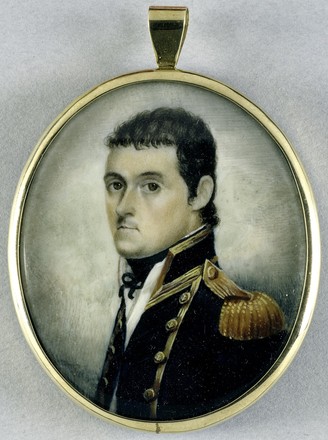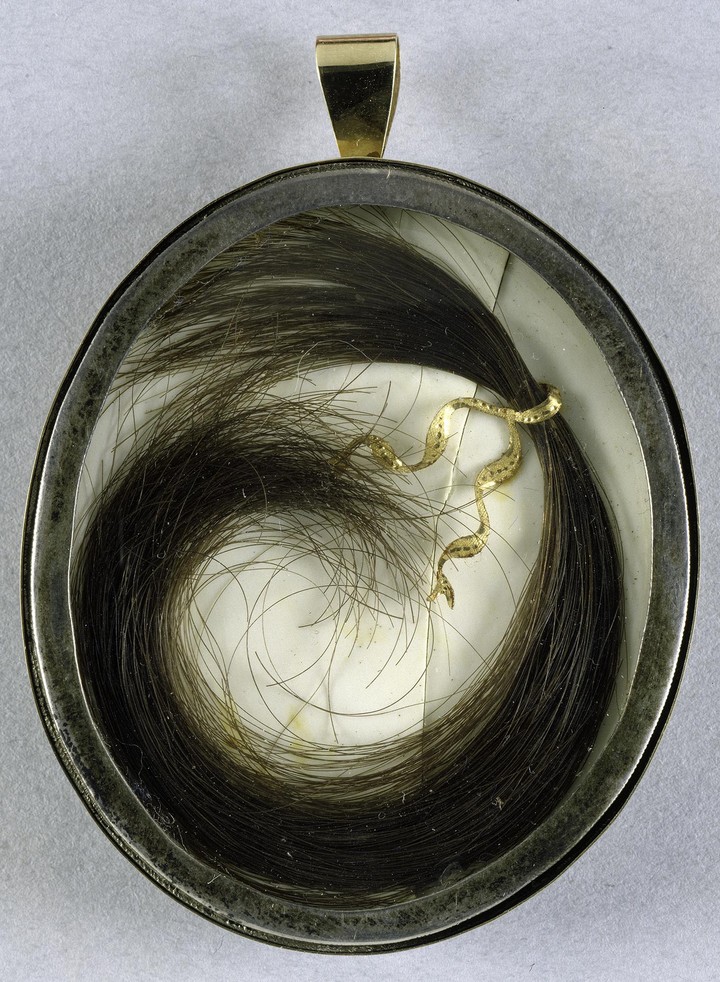Matthew Flinders, 1801
Watercolour on ivory miniature
Presented by Sir William Matthew Flinders Petrie, 1922
MIN 52
This miniature was painted after Flinders was promoted to commander in February 1801, but before the Investigator left England in July. It shows him in a commander's uniform, displaying that rank's single epaulet on the left shoulder. It was probably painted for his wife, Ann Chappelle, whom he married in April 1801. Ann's sister, Isabella Tyler, remembered him as 'chin rather projecting, his lips thin and compressed, nose inclining to aquiline, noble brow hair dark almost black - eyes dark, bright and commanding.'
A lifetime achievement
When we look at
the map of Australia, we are looking at the lifetime achievement of Matthew
Flinders. He compiled the first complete chart of the continent ‘Terra
Australis or Australia’ (published in January 1814), advocated the use of the
name ‘Australia’, and with George Bass, proved that Tasmania was an island.
Flinders defined the outline, suggested the name, and personalised the
resulting chart by adding hundreds of place names associated with his own life,
although he named nothing after himself.
Matthew Flinders: The ultimate voyage
By Paul Brunton, 2001
When we look at the map of Australia, we are looking at Matthew Flinders' memorial. He defined the outline, suggested the name, and personalised the resulting chart by adding hundreds of place names associated with his own life. No other national map is so intimately bound up with the life of one individual.
Matthew Flinders (1774–1814) proved that Tasmania was an island and produced its first map. He traced the coasts of the Australian continent, proving that the wast, New South Wales, was the same landmass as the west, New Holland.
He was the first to use 'Australian' to describe the inhabitants of this land and the first to use the word in a place name (the Great Australian Bight). He also splattered the map with the names of those who had assisted him; those who could still be of service; those who sailed with him and family and friends. However, he named nothing after himself and where 'Flinders' appears on the map today it is because others have honoured him.
His life was one of high professional achievement balanced by bitter personal tragedy. His detention by the French on Mauritius for six and a half years separated him from his wife, Ann, delayed the publication of his charts, and effectively finished his career at the age of 29. He died a painful death at the age of 40.
Lock of hair on the reverse of the Flinders miniature
On the back of miniature is enclosed a lock -
presumably Flinders - of hair. It was common for miniatures of this period to
incorporate locks of hair as a way of further humanising what could be very
personal and intimate images, often commissioned at a time of separation such
as that which Flinders and his wife were about to endure.
HMS Investigator
By http://flinders.rmg.co.uk
The Investigator was built in Sunderland in 1795 and started life as a collier
called the 'Fram'. It was bought by the Royal Navy and renamed Xenophon,
being renamed Investigator when selected for the voyage to Australia in 1800.
Colliers were often used for exploration as they had relatively shallow drafts
and lots of space for stores. The plan shows the changes that were made to the Investigator to prepare for the voyage: cabins were built for the scientists
and a plant cabin was built on the upper deck to take botanical specimens.



 Back to list
Back to list